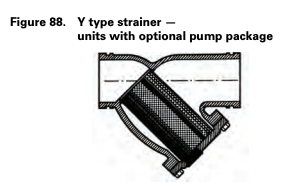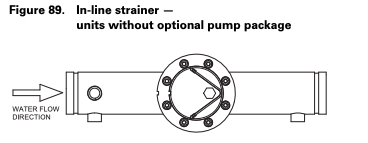CGAM Air-Cooled Scroll Chiller: Recommended Monthly Maintenance
This procedure is the recommended monthly maintenance procedure for your equipment. Performing all maintenance procedures and inspection at the recommended intervals will prolong the life of your chiller and minimize the possibility of malfunctions.
CGAM Air-Cooled Scroll Chiller: Recommended Monthly Maintenance
This procedure is the recommended monthly maintenance procedure for your equipment. Performing all maintenance procedures and inspection at the recommended intervals will prolong the life of your chiller and minimize the possibility of malfunctions.
! WARNING
Hazardous Voltage - Pressurized Burning Fluid!
Failure to follow all electrical safety precautions could result in death or serious injury.
Compressors on 110 and 120 ton, extra efficiency units, have strong permanent magnet motors that have the capability to generate voltage during situations when the refrigerant charge is being migrated. This potential will be present at the motor terminals and at the load side of compressor contactors.
Before removing compressor terminal box cover for servicing, or servicing power side of control panel, CLOSE COMPRESSOR DISCHARGE SERVICE VALVE and disconnect all electric power including remote disconnects. Follow lockout/tagout procedures to ensure the power cannot be inadvertently energized.
The compressor contains hot, pressurized refrigerant. Motor terminals act as a seal against this refrigerant. Care should be taken when servicing NOT to damage or loosen motor terminals.
Do not operate compressor without terminal box cover in place.
! WARNING
Hazardous Voltage!
Failure to disconnect power before servicing could result in death or serious injury. Disconnect all electric power, including remote disconnects before servicing. Follow proper lockout/tagout procedures to ensure the power can not be inadvertently energized.
Perform all maintenance procedures and inspection at the recommended intervals. This will prolong the life of the chiller and minimize the possibility of malfunctions.
Use an “Operator’s Log” to record the unit’s operating history. The log serves as a valuable diagnostic tool for service personnel. By observing trends in operating conditions, an operator can anticipate and prevent problem situations before they occur.
If the unit is not operating properly during maintenance inspections, see “Diagnostics,” p. 133.
Recommended Maintenance
Monthly
Note: The electronic expansion valve is commanded closed at unit shutdown and if the unit is off, there will be no refrigerant flow through the sight glasses. Only when a circuit is running will refrigerant flow be present.
The refrigerant flow through the sight glasses should be clear. Bubbles in the refrigerant indicate either low refrigerant charge or excessive pressure drop in the liquid line. A restriction in the line can sometimes be identified by a noticeable temperature differential between the two sides of the restriction. Frost may often form on the liquid line at this point. Correct refrigerant charges are shown in the General Data Tables.
Important: A clear sight glass alone does not mean that the system is properly charged. Also check the system superheat, subcooling and unit operating pressures.
Evaporator Maintenance
NOTICE: Equipment Damage!
The factory-installed immersion heater must be deenergized if the BPHE evaporator is drained of water for any reason. Failure to de-energize the immersion heater will cause it to burn out.
The Trane Model CGAM liquid chiller uses a brazed plate heat exchanger (BPHE) evaporator with factory-installed electronic flow switch (IFM efector) that is positioned in the evaporator water pipe. The evaporator inlet also includes a factory-installed immersion heater for freeze protection and a water strainer that must be kept in place to keep debris out of the evaporator.
Note: Strainer maintenance is critical to proper operation and reliability. Any particles larger than 1mm entering the BPHE evaporator may cause the evaporator to fail, requiring replacement.
Acceptable BPHE evaporator water flow rate is 1.5 to 3.6 GPM per nominal unit ton capacity. To maintain 54-44°F in/ out chilled water temperatures, the nominal water flow rate is 2.4 GPM/ton.
Minimum water flow rate must be maintained to avoid laminar flow, potential evaporator freezing, scaling and poor temperature control. The microprocessor and capacity control algorithms are designed to take a 10 percent change in water flow rate per minute while maintaining a ±2°F (1.1°C) leaving water temperature control accuracy. The chiller tolerates up to 30 percent per minute water flow variation as long as the flow is equal to or greater than minimum flow requirements.
Maximum water flow is 18 feet per second. Flow rates greater than this will cause excessive erosion.
The BPHE evaporator is difficult to clean should it become plugged with debris. Indications of a plugged BPHE evaporator include “wet” suction due to lack of heat exchange, loss of superheat control, depressed discharge superheat, compressor oil dilution and/or starvation and premature compressor failure.
Water Strainer Maintenance
For units with optional pump package, the factoryinstalled water strainer is a Y-type design with a cylindrical sieve.
An in-line strainer with a V-shaped sieve is used for units that do not have factory-installed pump package option.
The strainer is equipped with a blow-down port. The strainer is a 16 mesh (approximately 1 mm) material.
For maximum efficiency, a differential pressure gauge installed across the inlet and outlet will indicate pressure loss due to clogging and may be used as a guide to determine when cleaning is required. The taps for the pressure gauges are included as standard from the factory.
Normally when differential pressure reaches 5-10psi, the screen must be cleaned. The strainer is equipped with a blow-down port on the cover plate. To clean open and flush out until any sediment is removed.
Pump Package Maintenance
Rust Prevention
Pumps not immediately placed into service, or removed from service and stored, must be properly prepared to prevent excessive rusting.
For long term storage (3 months or longer), prevent internal rust buildup and possibility of freezing by performing the following steps:
When returning pumps to service:
Source: Trane (www.trane.com)


